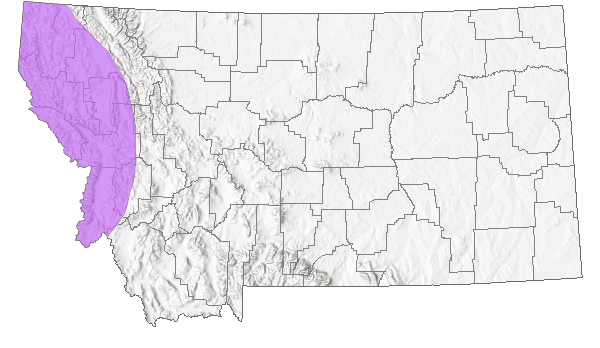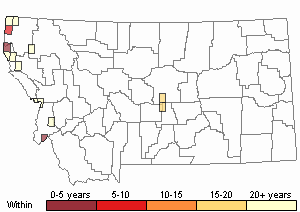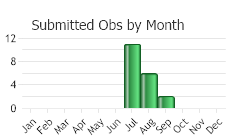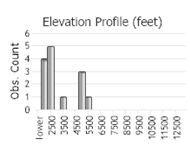View in other NatureServe Network Field Guides
NatureServe
Montana
Utah
Wyoming
Idaho
Wisconsin
British Columbia
South Carolina
Yukon
California
New York
Pyramidal Spiraea - Spiraea x pyramidata
Native Species
Global Rank:
GNA
State Rank:
S3S4
(see State Rank Reason below)
C-value:
Agency Status
USFWS:
USFS:
BLM:
External Links
State Rank Reason (see State Rank above)
Spiraea x pyramidata is a natural hybrid between Spiraea douglasii var. menziesii and Spiraea betulifolia var. lucida, which are all present in Montana. Populations have been found in northwest Montana. It is unclear if Montana populations are self-perpetuating or sporadic results in proximity to parental species. Surveys and monitoring that bring forth information on Montana’s population biology, locations, and habitats is needed.
General Description
PLANTS: A rhizomatous shrub with erect or spreading branches, 40-100 cm tall.
LEAVES: Alternately arranged, simple, and with petiole. Leaf blades are elliptic to obovate in shape, 3-7 cm long, glabrous, and with entire margins on the lower half and sharply toothed (doubly serrate) on the upper half. Leaves and stems are generally short-hairy.
INFLORESCENCE: Numerous tiny flowers occur in finely branched globose clusters that are grouped in a pyramid-shaped inflorescence at the top of the stems. Inflorescence is 5-10 cm wide at the base. Each flower has: a sparsely hairy, cup-shaped calyx, 1-2 mm long with 5 reflexed lobes; 5 pink-tinged petals, 2-3 mm long; 25-50 stamens; and a 5-lobed ovary that matures into a capsule 2-3 mm long.
Sources: Lis in FNA 2014; Lesica et al. (2012).
Phenology
Flowering May to July (Lis in FNA 2014).
Diagnostic Characteristics
Pyramidal Spiraea is a natural hybrid between
Spiraea douglasii var.
menziesii and
Spiraea betulifolia var.
lucida, which are all present in Montana.
Pyramidal Spiraea –
Spiraea x
pyramidata, native hybrid:
* Inflorescence is cone-shaped, about as long as broad or up to twice as long as broad.
* Flowers are pink-tinged.
White Spirea –
Spiraea betulifolia, native:
* Inflorescence is flat-topped to hemispheric, broader than long.
* Flowers are white.
* Leaves are glabrous.
* Montana’s variety is
lucida.
Douglas Spirea –
Spiraea douglasii, native:
* Inflorescence is cone-shaped, at least three times longer than broad.
* Flowers are pink to rose.
* Montana’s variety is
menziesii.
Source: Lesica et al. (2012).
Species Range
Montana Range
Range Descriptions

 Native
Native
Range Comments
British Columbia and Montana south to Oregon and Idaho (Lesica et al. 2012).
Observations in Montana Natural Heritage Program Database
Number of Observations: 21
(Click on the following maps and charts to see full sized version)
Map Help and Descriptions
Relative Density

Recency



 (Observations spanning multiple months or years are excluded from time charts)
(Observations spanning multiple months or years are excluded from time charts)
Habitat
Moist forests and streambanks in the valleys to lower subalpine zone in Montana. Outside of Montana Pyramidal Spiraea was found to colonize disturbed areas such as roadsides, railways, forest camps, and homesteads that are in proximity to both parents (Hess 1969).
Ecology
POLLINATORS The following animal species have been reported as pollinators of this plant species or its genus where their geographic ranges overlap:
Bombus vagans,
Bombus auricomus,
Bombus fervidus,
Bombus nevadensis,
Bombus ternarius,
Bombus griseocollis, and
Bombus impatiens (Macior 1968, Heinrich 1976, Colla and Dumesh 2010, Colla et al. 2011, Koch et al. 2012).
Reproductive Characteristics
In Washington populations of Pyramidal Spiraea are more distinct and no introgression appeared to occur from the parental taxa (Hess 1969). In British Columbia populations were less distinct and were mixed with hybrids, paretns, and probable introgressants (Hess 1969). Once established Pyramidal Spiraea can spread extensively by rhizomes (Hess 1969).
Stewardship Responsibility
References
- Literature Cited AboveLegend:
 View Online Publication
View Online Publication Colla, S., L. Richardson, and P. Williams. 2011. Bumble bees of the eastern United States. Washington, DC: USDA Forest Service, Pollinator Partnership. 103 p.
Colla, S., L. Richardson, and P. Williams. 2011. Bumble bees of the eastern United States. Washington, DC: USDA Forest Service, Pollinator Partnership. 103 p. Colla, S.R. and S. Dumesh. 2010. The bumble bees of southern Ontario: notes on natural history and distribution. Journal of the Entomological Society of Ontario 141:39-68.
Colla, S.R. and S. Dumesh. 2010. The bumble bees of southern Ontario: notes on natural history and distribution. Journal of the Entomological Society of Ontario 141:39-68. Koch, J., J. Strange, and P. Williams. 2012. Bumble bees of the western United States. Washington, DC: USDA Forest Service, Pollinator Partnership. 143 p.
Koch, J., J. Strange, and P. Williams. 2012. Bumble bees of the western United States. Washington, DC: USDA Forest Service, Pollinator Partnership. 143 p. Lesica, P., M.T. Lavin, and P.F. Stickney. 2012. Manual of Montana Vascular Plants. Fort Worth, TX: BRIT Press. viii + 771 p.
Lesica, P., M.T. Lavin, and P.F. Stickney. 2012. Manual of Montana Vascular Plants. Fort Worth, TX: BRIT Press. viii + 771 p. Macior, L.M. 1968. Bombus (Hymenoptera, Apidae) queen foraging in relation to vernal pollination in Wisconsin. Ecology 49:20-25.
Macior, L.M. 1968. Bombus (Hymenoptera, Apidae) queen foraging in relation to vernal pollination in Wisconsin. Ecology 49:20-25.
- Additional ReferencesLegend:
 View Online Publication
View Online Publication
Do you know of a citation we're missing? Hess, W.J. 1969. A taxonomic study of Spiraea pyramidata Greene (Rosaceae). SIDA 3(5):298-308.
Hess, W.J. 1969. A taxonomic study of Spiraea pyramidata Greene (Rosaceae). SIDA 3(5):298-308. Lackschewitz, K., P. Lesica, and J. S. Shelly. 1988. Noteworthy collections: Montana. Madrono 35:355-358.
Lackschewitz, K., P. Lesica, and J. S. Shelly. 1988. Noteworthy collections: Montana. Madrono 35:355-358. Lesica, P., M.T. Lavin, and P.F. Stickney. 2022. Manual of Montana Vascular Plants, Second Edition. Fort Worth, TX: BRIT Press. viii + 779 p.
Lesica, P., M.T. Lavin, and P.F. Stickney. 2022. Manual of Montana Vascular Plants, Second Edition. Fort Worth, TX: BRIT Press. viii + 779 p. Schassberger, L.A. 1991. Rare plant inventory of the East Pioneer Mountains. Prepared for the USDA Forest Service, Region 1, Beaverhead National Forest. Montana Natural Heritage Program, Helena, MT. 55 pp.
Schassberger, L.A. 1991. Rare plant inventory of the East Pioneer Mountains. Prepared for the USDA Forest Service, Region 1, Beaverhead National Forest. Montana Natural Heritage Program, Helena, MT. 55 pp. Schassberger, L.A. and J.S. Shelly. 1990. Sensitive plant surveys in the Bull River and adjacent drainages, USDA Forest Service, Region 1, Kootenai National Forest. Unpublished report. Montana Natural Heritage Program, Helena, MT. 60 pp.
Schassberger, L.A. and J.S. Shelly. 1990. Sensitive plant surveys in the Bull River and adjacent drainages, USDA Forest Service, Region 1, Kootenai National Forest. Unpublished report. Montana Natural Heritage Program, Helena, MT. 60 pp.
- Web Search Engines for Articles on "Pyramidal Spiraea"





